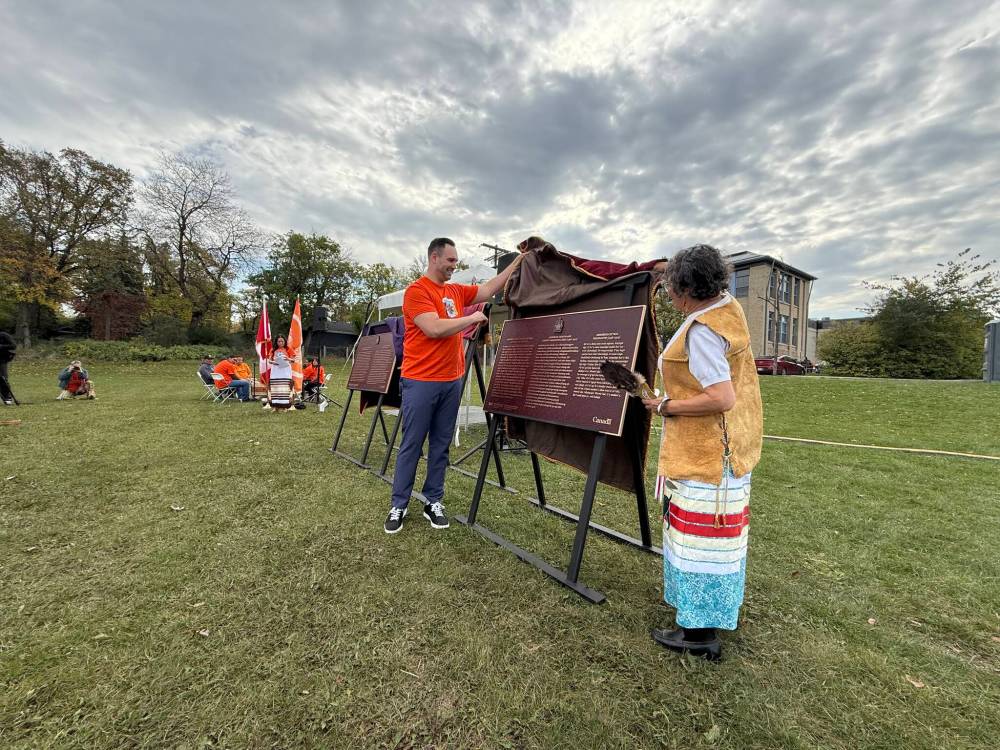Silenced no more: Indigenous languages celebrated at site of former residential school
Advertisement
Read this article for free:
or
Already have an account? Log in here »
To continue reading, please subscribe:
Monthly Digital Subscription
$1 per week for 24 weeks*
- Enjoy unlimited reading on winnipegfreepress.com
- Read the E-Edition, our digital replica newspaper
- Access News Break, our award-winning app
- Play interactive puzzles
*Billed as $4.00 plus GST every four weeks. After 24 weeks, price increases to the regular rate of $19.00 plus GST every four weeks. Offer available to new and qualified returning subscribers only. Cancel any time.
Monthly Digital Subscription
$4.75/week*
- Enjoy unlimited reading on winnipegfreepress.com
- Read the E-Edition, our digital replica newspaper
- Access News Break, our award-winning app
- Play interactive puzzles
*Billed as $19 plus GST every four weeks. Cancel any time.
To continue reading, please subscribe:
Add Winnipeg Free Press access to your Brandon Sun subscription for only
$1 for the first 4 weeks*
*$1 will be added to your next bill. After your 4 weeks access is complete your rate will increase by $0.00 a X percent off the regular rate.
Read unlimited articles for free today:
or
Already have an account? Log in here »
Languages once suppressed at the Assiniboia Residential School have now returned to the site.
More than 100 people gathered Tuesday at 621 Academy Rd., on the National Day for Truth and Reconciliation, for a ceremony unveiling three plaques near the former school.
The plaques are written in Anishinaabemowin, Anishininimowin, Cree, Dakota, Dene, English and French — reflecting the languages spoken by children who attended the school.

Scott Billeck / Free Press
More than 100 people gathered Tuesday at 621 Academy Rd., on the National Day for Truth and Reconciliation, for a ceremony unveiling three plaques near a former residential school.
“It’s very important, and it can also be quite emotional,” said Darian McKinney, a board member for the Assiniboia Residential School Legacy Group, whose grandparents were residential school survivors.
“Growing up, (those languages) were something that was non-existent. My grandparents, specifically, did not teach my father the language because of the threat of being taken away by residential schools. Just knowing that’s why I don’t know the language is heartbreaking.”
McKinney said his grandparents’ first language was Anishinaabemowin.
“Going to (Sandy Bay Residential School), it was forbidden,” he said. “And they didn’t speak it after that, although they’ve definitely reclaimed it and speak it more now.”
The Assiniboia Residential School operated from 1958 to 1973 in a repurposed building that had served as a children’s home and later a veterans’ hospital.
Run by the Oblates of Mary Immaculate and the Grey Nuns of Montréal, it was federally funded and part of Canada’s policy of forced assimilation. Inspections in the 1960s cited overcrowding and unsafe conditions.
The residential school system removed Indigenous children from their cultures and families, causing deep harm and has been recognized by the Truth and Reconciliation Commission as cultural genocide.
“Our relatives and ancestors have a fire spirit within them,” said Toni Kipling, executive director of the legacy group. “This fire provided the strength, resilience and love to endure the pain and injustices while they were uprooted and forced to attend residential schools. It is because of their bravery and strength, we are still here.”
Liberal MP Ben Carr said he grew up only a few blocks from the former school but knew little about it.
“Residential school history was not widespread … and certainly we did not have knowledge of places like this existing in our own backyard,” Carr said. “We were not exposed, as white kids in this part of town, to Indigenous communities, never mind understanding the past in the present.”
He said his young niece, who attended the event, will learn what he did not.
“The importance of places like this, the sign that remains here, the memorial, the commemorative plaques being placed here today, all play a very critical role in ensuring that kids like my niece, and even adults not familiar with this history, can move forward with a deeper understanding of where we’ve come from and where we have to go,” he said.
scott.billeck@freepress.mb.ca

Scott Billeck is a general assignment reporter for the Free Press. A Creative Communications graduate from Red River College, Scott has more than a decade’s worth of experience covering hockey, football and global pandemics. He joined the Free Press in 2024. Read more about Scott.
Every piece of reporting Scott produces is reviewed by an editing team before it is posted online or published in print — part of the Free Press‘s tradition, since 1872, of producing reliable independent journalism. Read more about Free Press’s history and mandate, and learn how our newsroom operates.
Our newsroom depends on a growing audience of readers to power our journalism. If you are not a paid reader, please consider becoming a subscriber.
Our newsroom depends on its audience of readers to power our journalism. Thank you for your support.


